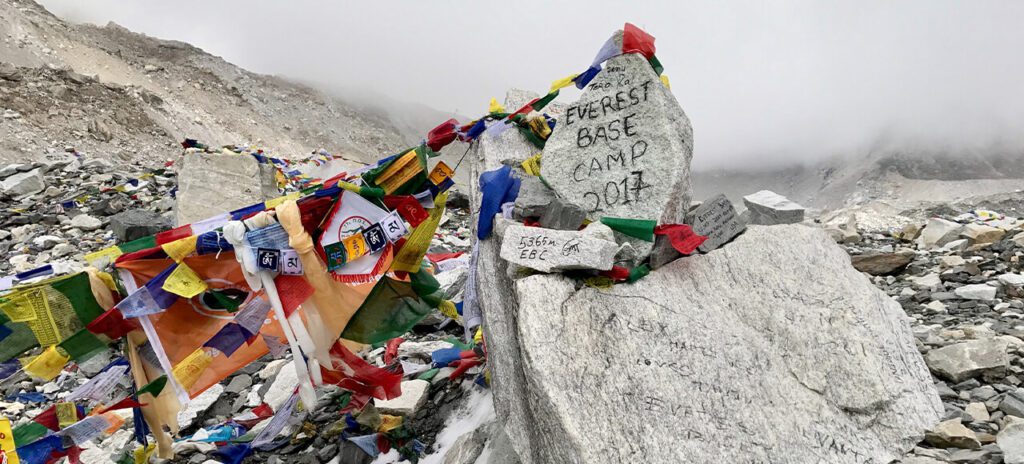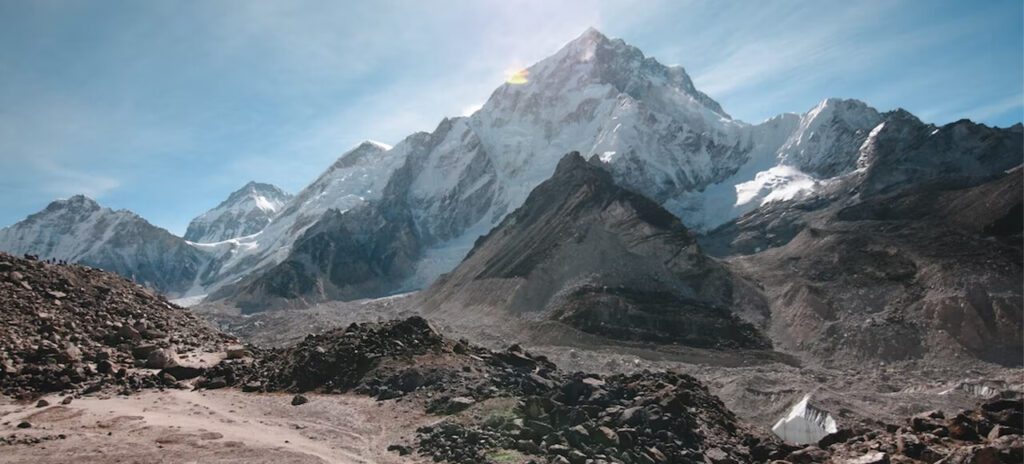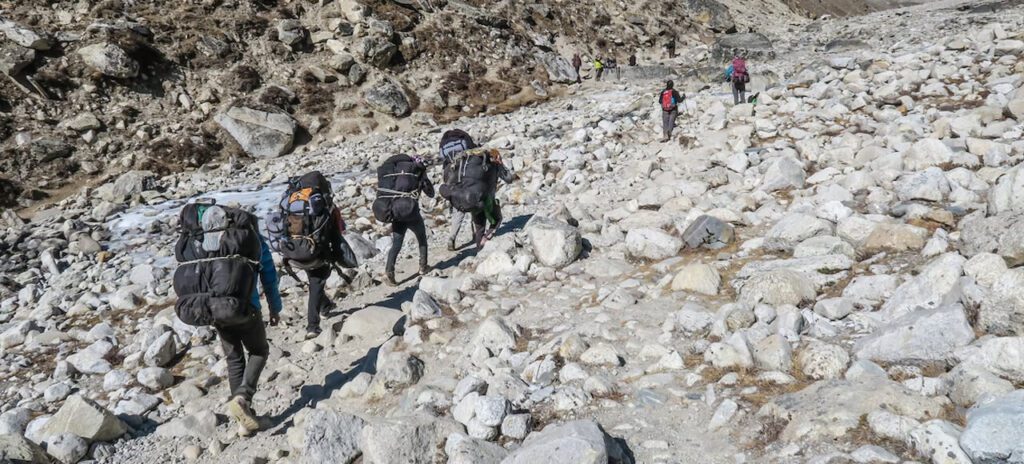Get ready to be blown away because we’re talking about the king of all mountains Mount Everest. This colossal wonder is a sight to behold towering over the surrounding landscape like a giant among mere mortals. It’s a symbol of the incredible power of nature and the boundless ambition of human beings. Nestled in the majestic Himalayan range Mount Everest commands respect from all who behold its towering peak. It’s a stunning reminder of the incredible natural beauty that surrounds us and it’s impossible not to feel humbled in its presence.
Here are some mind-blowing facts about Mount Everest:
Age of Mount Everest
The age of Mount Everest is estimated to be around 60 million years old which makes it relatively young in terms of geological time. It was formed as a result of the collision between the Indian and Eurasian tectonic plates which forced the land upwards and created the Himalayan mountain range.

Its youthful age and towering height make it a marvel of the natural world and a bucket list destination for many adventurous climbers and mountaineers.
Mount Everest is the tallest mountain in the world
It’s a fact that needs no introduction – Mount Everest is the tallest mountain on Earth. Standing tall at a jaw-dropping 8,848.86 meters above sea level this majestic wonder of nature has captivated the hearts and minds of adventurers, climbers, and nature enthusiasts from all corners of the globe. It’s a symbol of human ambition and perseverance. For centuries people have been drawn to Mount Everest eager to test their limits and prove their mettle in the face of extreme adversity.

And while many have attempted to climb this legendary peak only a select few have ever reached its summit. But it’s not just the height or the challenge that makes Mount Everest so awe-inspiring. It’s the sheer beauty of the mountain itself from the snow-capped peak that seems to touch the sky to the sprawling glaciers that surround its base. It’s a stunning reminder of the incredible natural beauty that surrounds us and the power of nature to inspire and humble us all.
The naming of Mount Everest
Mount Everest also known as Sagarmatha in Nepal and Chomolungma in Tibet was named after Sir George Everest a British surveyor who was responsible for mapping much of India and the Himalayas in the 19th century. Sir George Everest was the Surveyor General of India from 1830 to 1843 and oversaw the Great Trigonometric Survey of India which was a comprehensive survey of the Indian subcontinent that aimed to accurately measure the height of the Himalayan peaks.
Also Read: An Overview of Everest Base Camp
The survey involved using theodolites and other instruments to measure the angles between the peaks and the horizon and then using mathematical calculations to determine their height.
The first successful ascent
May 29, 1953, was a day that changed history forever. It was on this day that Sir Edmund Hillary of New Zealand and Tenzing Norgay a Sherpa of Nepal successfully climbed to the summit of Mount Everest making them the first human beings to ever reach the top of the world’s tallest mountain. Their ascent was marked by incredible bravery, determination, and perseverance. They faced extreme weather conditions, treacherous terrain, and the constant threat of avalanches and falls.

But they pressed on, driven by the desire to achieve something truly remarkable and to push the boundaries of human possibility. When they finally reached the summit they made history. The world was captivated by their achievement and their names became synonymous with courage and adventure.
Mount Everest is currently undergoing growth and is still increasing in height
Mount Everest is often referred to as the Roof of the World because of its impressive height but what many people don’t realize is that it’s still growing. As the plates continue to collide, the Himalayas continue to rise and Mount Everest is no exception. While it may not seem like much the fact that Mount Everest is growing at a rate of about 4 millimeters per year is actually quite remarkable. For climbers and adventurers, the growth of Mount Everest also presents a unique challenge.
Also Check: Everest Base Camp Trek Route
As the mountain continues to rise the routes and conditions for climbing may change making it an even more unpredictable and dangerous challenge than it already is. But for those who are willing to take on the challenge, the opportunity to conquer one of the world’s tallest and most impressive natural wonders remains as inspiring and awe-inspiring as ever.
The peak of Mount Everest has an extremely thin atmosphere
Reaching the summit of Mount Everest is a goal that many climbers aspire to but what many people don’t realize is just how challenging it can be to breathe at such high altitudes. The summit of Mount Everest is known as it is the highest point on Earth. At this altitude, the air is extremely thin and the amount of oxygen available is only about one-third of what is available at sea level.
The lack of oxygen at the summit of Mount Everest can have serious consequences for climbers. It can cause dizziness, confusion, and difficulty breathing, and in extreme cases, it can even lead to death. To combat these effects climbers often use supplemental oxygen which allows them to breathe more easily and stay alert and focused during the climb.
Scaling Mount Everest Poses an immense level of Danger
Scaling Mount Everest the highest peak in the world is an incredibly perilous endeavor that requires a significant amount of skill, experience, and preparation. The mountain’s extreme altitude, severe weather conditions, unpredictable avalanches, and treacherous terrain all contribute to the significant danger that climbers face. Many climbers suffer from altitude sickness which can cause symptoms such as headaches, nausea, and shortness of breath.
More: Everest Base Camp Height: From Sea Level to Summit
In severe cases, altitude sickness can lead to cerebral edema, which can be fatal. The mountain’s terrain is incredibly challenging with steep slopes, icefalls, and crevasses that can easily trap and injure climbers. Avalanches are also a constant threat, particularly in the Khumbu Icefall. Even with the use of modern equipment and safety measures climbing Mount Everest remains an extremely risky activity that requires a high level of skill, experience, and physical and mental endurance.
Mount Everest is home to some of the world’s largest glaciers
Some of the world’s biggest glaciers which were created by the accumulation of snow over many decades can be found on Mount Everest. Some of them are:
Khumbu Glacier
The Khumbu Glacier is the largest glacier on Mount Everest, located in the Western Cwm on the south side of the mountain. It stretches for about 17 miles and is approximately 1,640 feet wide. This massive glacier is a prominent feature of the landscape and a vital source of freshwater for the region. The Khumbu Glacier starts at the Khumbu Icefall which is considered to be one of the most dangerous parts of the climb up Mount Everest.

The icefall is a section of the glacier where the ice is constantly breaking and moving creating deep crevasses and unstable ice formations. Climbers must navigate this treacherous terrain carefully using ladders and ropes to cross the crevasses and avoid falling into the ice.
Rongbuk Glacier
The Rongbuk Glacier is one of the largest glaciers on Mount Everest located on the north side of the mountain in Tibet. This glacier stretches for about 11 miles and is a significant feature of the landscape. It is the primary source of freshwater for the Rongbuk Valley which is home to the Rongbuk Monastery the highest monastery in the world.
It is also serving as a vital water source for the local communities supporting the agriculture and livestock farming industries in the region. Ice towers, seracs, and icefalls are just a few of the intriguing ice structures that can be found on the Rongbuk Glacier. It is common to go exploring and take pictures of these structures which are the result of the glacier’s continuous movement.
The economy of the Everest region is heavily dependent on tourism
The economy of the Everest region is heavily dependent on tourism. Mount Everest is the main attraction for tourists visiting the region and many people come to Nepal specifically to climb the mountain or to trek in the surrounding area. Tourism has become a major source of income for the local communities, particularly the Sherpa people who live in the region. They provide various services to tourists, such as guiding, portering, and other support services.
Also Check: Food and Accommodation on Everest Base Camp Trek
Many Sherpas have become skilled mountaineers and guides and they are in high demand from tourists who want to climb Mount Everest. The tourism industry has also created jobs in other sectors, such as hospitality, transportation, and construction. Hotels, lodges, and restaurants have sprung up in the area to cater to tourists, providing employment opportunities for local people. In addition, the tourism industry has created a demand for transportation services including taxis and buses which has created job opportunities for drivers.
The economy of the Everest region is also boosted by the sale of handicrafts and souvenirs to tourists. Local artisans create traditional crafts such as woolen hats, scarves, and blankets which are popular with tourists. These handicrafts provide an additional source of income for local people.
Climbing Mount Everest: Successes and Tragedies
Climbing Mount Everest is a challenging and dangerous endeavor with a long history of both successful summits and tragic losses. Since the first successful ascent of Mount Everest in 1953 by Sir Edmund Hillary and Tenzing Norgay over 4,000 people have reached the summit. However, this achievement has come at a high cost as more than 300 people have lost their lives attempting the climb. Despite the risks, Mount Everest continues to draw climbers from around the world seeking to test their limits and reach the highest point on Earth.
The spiritual significance of Mount Everest
Mount Everest is not only a physical marvel but it also holds great spiritual significance to the people who live in the surrounding regions. The mountain is considered sacred to both Buddhists and Hindus and is known as Chomolungma to Tibetans and Sagarmatha to Nepalese. This topic explores the spiritual significance of Mount Everest to these cultures examining the various religious and cultural beliefs associated with the mountain. It also looks at how these beliefs have influenced the way that the mountain is treated and preserved both by the local communities and by climbers from around the world. Finally, the topic discusses how the spiritual significance of Mount Everest intersects with the environmental and political issues facing the region highlighting the complex relationship between culture, religion, and the natural world.
The sherpa people: Guides and Guardians of Mount Everest
The area surrounding Mount Everest is home to many Sherpa people an ethnic group with a rich history and culture. For generations, the Sherpa have served as guides and porters for climbers attempting to summit Mount Everest and have played a crucial role in the development of the climbing industry in the region.

This topic explores the history and culture of the Sherpa people, examining their traditional way of life, beliefs, and customs. It also looks at the role that the Sherpa have played in the development of the climbing industry around Mount Everest and the challenges they face in the face of growing tourism and environmental degradation.
Mount Everest clean-up campaign- 2019
In 2019, a massive clean-up campaign was organized on Everest, the highest peak in the world. The campaign was jointly organized by the Government of Nepal and the Sagarmatha Pollution Control Committee with the support of various mountaineering and environmental organizations. The main objective of the campaign was to remove the tons of trash, abandoned climbing equipment, and human waste that had accumulated on the mountain over the years.
Everest has been a popular destination for climbers for decades and the increasing number of climbers has resulted in a significant amount of waste being left behind on the mountain. The waste includes empty oxygen canisters, food wrappers, climbing gear, and even human waste, which has caused serious environmental concerns.







